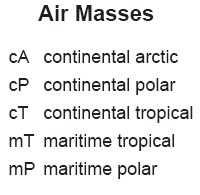Air Masses
An air mass is a large body of air with generally uniform temperature and humidity. The area from which an air mass originates is called a "source region."
Air mass source regions range from extensive snow covered polar areas to deserts to tropical oceans. The longer the air mass stays over its source region, the more likely it will acquire the properties of the surface below.
The four principal air mass classifications that influence the continental United States according to their source region are:
-
Polar latitudes - Located poleward of 60° north and south.
-
Continental - Located over large land masses between 25°N/S and 60°N/S.
-
Maritime - Located over the oceans between 25°N/S and 60°N/S
-
Tropical latitudes - Located within about 25° of the equator.

As these air masses move around the earth they can begin to acquire additional attributes. For example, in winter an arctic air mass (very cold and dry air) can move over the ocean, picking up some warmth and moisture from the warmer ocean and becoming a maritime polar air mass (mP) - one that is still fairly cold but contains moisture. If that same polar air mass moves south from Canada into the southern U.S. it will pick up some of the warmth of the ground, but due to lack of moisture it remains very dry. This is called a continental polar air mass (cP).

The Gulf Coast states and the eastern third of the country commonly experience the tropical air mass in the summer. Continental tropical (cT) air is dry air pumped north, off of the Mexican Plateau. If it becomes stagnant over the Midwest, a drought may result. Maritime tropical (mT) air is air from the tropics which has moved north over cooler water.
Air masses can control the weather for a relatively long time period: from a period of days, to months. Most weather occurs along the periphery of these air masses at boundaries called fronts.